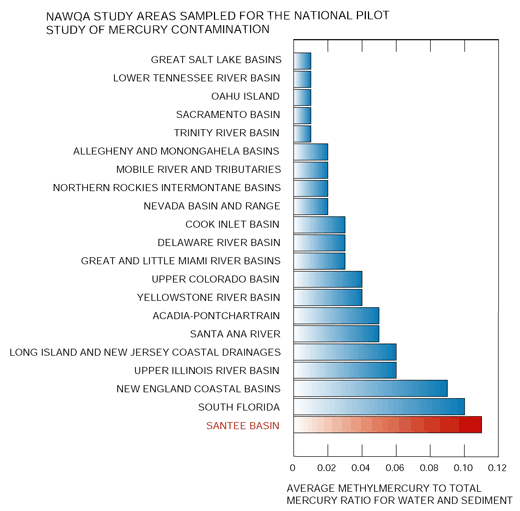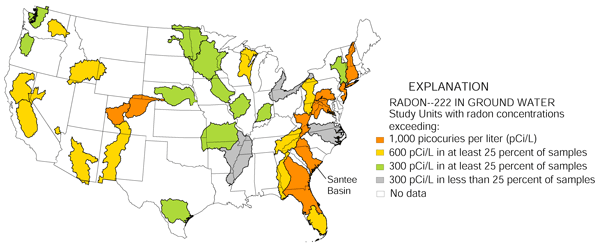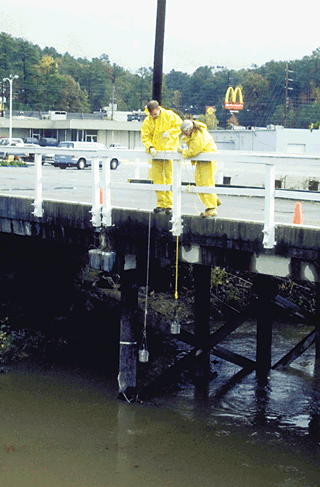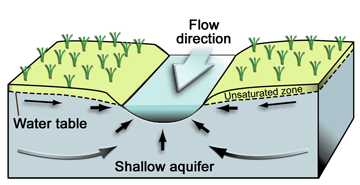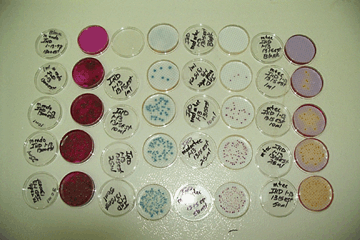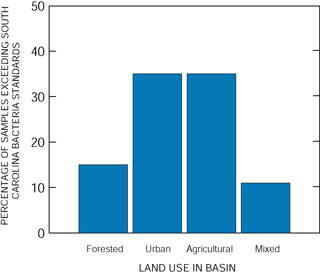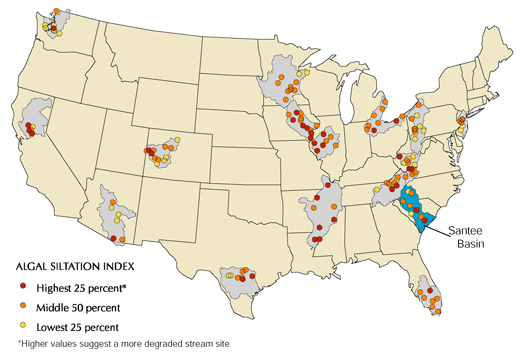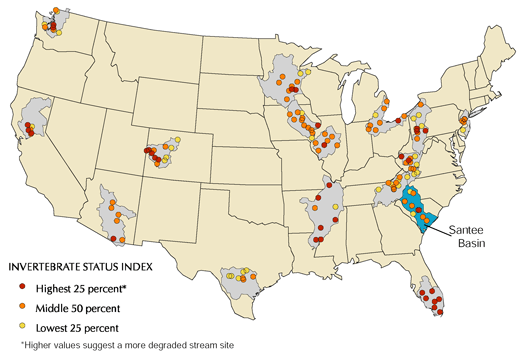MAJOR FINDINGS—Continued
Bed Sediment Had Low Concentrations of Trace Elements
Trace elements in bed sediment were detected frequently but mostly at concentrations below those expected to affect aquatic life (Canadian Council of Ministers of the Environment, 1995). Arsenic and lead exceeded aquatic standards in one sample each, and chromium exceeded standards in four samples. The samples with elevated chromium concentrations were not associated with any particular land use; however, most of these samples were collected at sites in the Piedmont. This suggests that the elevated concentrations may be naturally occurring as a result of geologic conditions in the Piedmont.
Regional differences in bed sediment trace-metal concentrations were observed in the study area. In general, a decrease in the bed-sediment concentrations of arsenic, chromium, copper, nickel, and zinc occurs from the Blue Ridge southeastward across the Piedmont to the Coastal Plain. In the same direction, an increase in the bed-sediment concentrations of lead, mercury, and selenium occurs. These differences are likely a result of geologic differences among the areas (Abrahamsen, 1999).
A comparison of land use with bed sediment trace-element concentrations indicates that lead is significantly higher in sediment from urban streams than in sediment from forested streams. Neither agricultural nor mixed land-use streams had significantly higher concentrations of lead than forested streams (Abrahamsen, 1999).
|
Mercury is a widespread and extremely toxic contaminant that affects the Nation’s aquatic ecosystems. Approximately 80 percent of the fish consumption advisories in the Nation were issued as a result of contamination by mercury (U.S. Environmental Protection Agency, 1998). Methylmercury is the form of mercury that is easily accumulated in the tissues of organisms. As part of the NAWQA Program, a nationwide investigation of methylmercury in water, sediment, and fish tissues was conducted (Krabbenhoft and others, 1999). Analysis of samples collected in the Santee Basin indicated that they had the greatest methylation efficiency (the ratio of methylmercury to total mercury) in the Nation. In other words, conditions at the sites sampled in the Santee Basin are such that a relatively small amount of elemental mercury in water can result in high concentrations of methylmercury being available for accumulation in fish tissue. The types of sites sampled were primarily blackwater streams, which typically have large amounts of dissolved organic carbon and low dissolved oxygen concentrations. The bacteria that convert elemental mercury to methylmercury thrive under these conditions. Many of the streams that are covered by State fish-consumption advisories are blackwater streams.
|
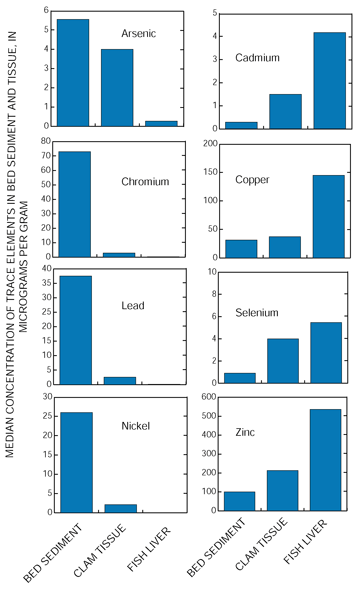 |
| Figure 15. Cadmium, copper, selenium, and zinc were detected at higher concentrations in clam and fish tissue than in sediment, suggesting that they accumulate in the tissues. Conversely, arsenic, chromium, lead, and nickel were detected in lower concentrations in tissues than in sediment, indicating that these metals do not accumulate in the tissues. |
Trace Elements Accumulated in Clam Tissue and Fish Livers
Trace metals are naturally occurring and were detected in all fish liver and clam tissue samples collected. Nine trace elements (arsenic, cadmium, chromium, copper, lead, mercury, nickel, selenium, and zinc) have been classified as priority pollutants because they are toxic to aquatic organisms in low concentrations (Code of Federal Regulations, 1996). Of these nine metals, concentrations of cadmium, copper, selenium, and zinc were higher in clams and fish liver tissue than those measured in sediment. Carp liver tissue contained significantly higher concentrations of these metals than those in clams and bed sediment, indicating that the metals accumulate in fish livers. Concentrations of arsenic, chromium, lead, and nickel were significantly lower in tissues than in sediment, suggesting that these metals do not accumulate in tissues (fig. 15). Concentrations of mercury were higher in clam tissue than in sediment and fish livers. Although data suggest that some metals accumulate in tissues, most metals do not have criteria for assessing risk to human health or aquatic wildlife associated with fish consumption.
Concentrations of mercury in clams and fish liver tissue from the Edisto River were 24 and 8 times greater, respectively, than the South Carolina action level for issuance of a fish-consumption advisory. Data collected in the NAWQA Program cannot be used to assess potential risk to human health because fish livers were used for analyses, whereas fish fillets are needed to assess human-health risk. Consumption advisories generally are not applied to clams because few humans consume them. The South Carolina Department of Health and Environmental Control (2000) has issued fish-consumption advisories because of high levels of mercury in 49 rivers and reservoirs in the Santee Basin, including the Edisto River.
Radon Exceeded Proposed Standards in Many Wells
Ninety-six percent of the 90 wells sampled in drinking-water supply aquifers of the Santee Basin contained measurable quantities of radon, a colorless, odorless gas that can cause cancer in humans. The gas results from the radioactive decay of uranium in rocks and soil and can enter homes directly from the soil or in drinking water supplied by wells. Radon is a health risk through direct inhalation of the gas and from drinking water contaminated with radon.
Of the 90 wells sampled, radon exceeded the USEPA’s (1999) proposed maximum contaminant level (MCL) of 300 picocuries per liter (pCi/L) in 100, 47, and 17 percent of the wells in the Piedmont, Sandhills, and Floridan aquifers, respectively (fig. 16). For wells not meeting the MCL, the USEPA has proposed an Alternative Maximum Contaminant Level (AMCL) of 4,000 pCi/L. To comply with the AMCL, the State or local water utility must develop indoor air radon-reduction programs and reduce radon levels in drinking water to 4,000 pCi/L. Of the wells that were sampled in the Piedmont, Sandhills, and Floridan aquifers, 20 percent, zero percent, and less than 1 percent, respectively, exceeded the proposed AMCL.
Wells in the Piedmont had much higher concentrations of radon, on average, than wells sampled in the Sandhills and Floridan aquifers (fig. 16). This results from the greater relative abundance of minerals containing uranium in the metamorphic rocks that compose the Piedmont aquifer. The same bedrock underlies the Sandhills and Floridan aquifers, but generally at depths ranging from several hundred to several thousand feet.
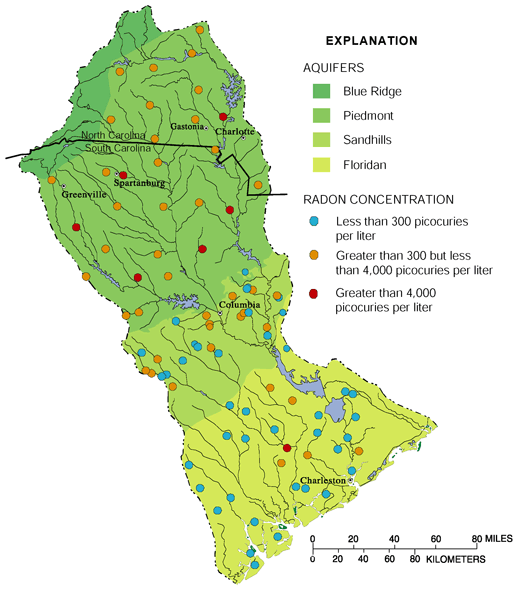 |
| Figure 16. Radon concentrations were highest in the Piedmont and Sandhills aquifers, resulting from naturally high levels of uranium in near-surface rocks and sediment. |
|
Radon concentrations in the Santee Basin were among the highest measured in the Nation. These high concentrations result from radioactive decay of naturally occurring minerals in the soil and rock that underlie the study area and compose the aquifer in the Piedmont part of the study area. The Piedmont metamorphic rocks are present in many eastern coastal States and probably account for the high radon concentrations observed in Study Units located in those States.
|
Volatile Organic Compounds Were Common in Urban Ground Water
All but 3 of 30 monitoring wells installed in commercial and residential areas of Columbia, S.C., contained a variety of volatile organic compounds (VOCs), a group of chemicals that includes gasoline additives, solvents, and disinfection by-products (Reuber, 1999). Thirty-five such compounds were detected. Most wells contained three or more VOCs, and one well contained 15 different VOCs.
Most of the VOC detections were at extremely low levels. The five VOCs detected with the highest concentrations were methyl tert-butyl ether (MTBE), trichloroethene (TCE), acetone, tert-amyl methyl ether (TAME), and trichloromethane. Of the 35 detected VOCs, 21 have established drinking-water standards; of these, only TCE exceeded the standard. Currently there is no standard for MTBE, but the MTBE concentration in one well exceeded a drinking-water advisory.
|
|
|
| Shallow ground water in the Columbia, S.C., metropolitan area contains a variety of volatile organic compounds, but mostly at low concentrations. |
Some of the most frequently detected compounds included trichloromethane, chloromethane, and bromodichloromethane. These compounds can result from the chlorination of drinking water and can enter ground water by infiltration from irrigation systems or from leaky water-supply lines. Other VOCs that were detected were solvents, such as TCE, tetrachloroethene, and acetone. These compounds have commercial and industrial uses as degreasers and dry-cleaning solvents, but they are often used in households for similar purposes. The gasoline additives MTBE and TAME and the gasoline component benzene also were detected in Columbia’s ground water. These compounds can enter ground water from leaking gasoline storage tanks, spills, and potentially through atmospheric deposition (Lopes, 1998).
The diffuse, nonpoint nature of sources of VOCs in ground water makes it difficult to attribute detected compounds to particular homes or businesses, posing a problem for scientists who seek to establish the relative importance of these sources and for regulators who seek to educate the public or control the release of toxic substances.
Volatile Organic Compounds in Streams Can Result from Ground-Water Discharge and Urban Runoff
|
|
| Stormwater samples for volatile organic compounds were collected by using special samplers developed for the NAWQA Program. |
Ten VOCs were detected in seven monthly stream-water samples that were collected from Gills Creek, an urban stream in the Columbia metropolitan area. MTBE, chloromethane, methylbenzene, chlorobenzene, and acetone were detected most frequently. None of the VOCs detected in Gills Creek were at concentrations exceeding drinking-water or aquatic-life standards. Six of the VOCs detected do not have standards.
VOCs have many sources, including contaminated precipitation, surface-water runoff, and ground-water discharge. Though the sources are diffuse and hard to measure directly, inferences can be made about the likely sources. For example, samples collected in Gills Creek while the water level was rising during a rainstorm indicate that as streamflow increased, the concentration of acetone increased. This suggests that the source of acetone in the samples was from contaminated precipitation or stormwater runoff (Lopes and others, 2000). If the acetone resulted from continuously discharging ground water, the concentration would be expected to decrease as dilution by rainfall and runoff increased.
During the summer of 1996, 20 different VOCs were detected at low concentrations in individual samples collected at 16 surface-water sites scattered throughout the Gills Creek Basin. The compounds detected in the highest concentrations included MTBE, 1,1-dichloroethene, trichloroethene, methylbenzene, and 1,2-dibromo-3-chloropropane—all solvents except for MTBE, which is a gasoline additive. Fifteen of the compounds detected in surface water also were present in the Columbia ground-water samples. This result is not surprising because the samples were collected during low streamflow conditions when the ground-water contribution to Gills Creek is greatest; consequently, VOCs from contaminated ground water most likely would be detected in stream samples.
Drinking-Water Aquifers Had Low Concentrations of Volatile Organic Compounds
Of the 90 wells sampled in the Piedmont, Sandhills, and Floridan aquifers, 62 contained detectable concentrations of VOCs. All of the 28 compounds detected met USEPA drinking-water standards; however, 19 of the compounds did not have standards. The VOCs measured had widely ranging detection limits, making comparisons among compounds and aquifers difficult. A subset of the compounds having detection limits of 0.05 microgram per liter (mg/L) or lower was used to make comparisons. This comparison shows that about twice as many wells in the Sandhills aquifers contain VOCs as those in the Floridan and Piedmont aquifers. The more frequent occurrence of VOCs in the Sandhills aquifers probably relates to their greater susceptibility to contamination.
Data on VOCs in drinking-water aquifers indicate that although these compounds are widespread, concentrations are sufficiently low that human health is not immediately at risk. However, the fact that detections were so frequent suggests that aquifers are susceptible to contamination and should be carefully monitored.
|
Ground water affects the quality of surface water
Presently, surface water is used for most public water supplies in the Columbia metropolitan area. However, the quality of these supplies is largely controlled by ground-water quality, especially during summer months. In areas of the basin with sandy soils, such as the Sandhills, flow in streams is contributed mostly by discharge from ground water. Discharging ground water transports contaminants, including VOCs, that can result in water-quality problems in streams and lakes. Consequently, the health of aquatic organisms and surface-water drinking supplies can be affected by the chemical quality of shallow ground water discharged to streams and reservoirs. Several streams in the metropolitan area, including Penn Branch and Jackson Creek, have high concentrations of nutrients and pesticides that evidence suggests result from ground-water discharge (Maluk, 1999). |
Urban and Agricultural Streams Had High Concentrations of Bacteria
|
|
| Bacterial cultures were prepared and counted in a mobile field laboratory and in the USGS South Carolina District laboratory. |
Thirteen of 17 streams sampled for fecal coliform bacteria had at least one sample that exceeded the South Carolina single-sample standard of 400 colonies per 100 milliliters (cols/100 mL; South Carolina Department of Health and Environmental Control, 1992). This standard was implemented to reduce the risk of gastrointestinal disorders that are associated with recreational contact with water containing elevated levels of bacteria. All concentrations measured in this report were compared to South Carolina standards for consistency; North Carolina does not recognize a single-sample standard.
|
|
| Figure 17. Urban and agricultural streams had more concentrations of bacteria that exceeded South Carolina State standards than forested and mixed land-use streams. |
Urban and agricultural streams had more concentrations of bacteria that exceeded standards than forested and mixed land-use streams (fig. 17). Several creeks repeatedly had high concentrations of bacteria. For example, one of the urban streams sampled, Brushy Creek, exceeded the standard in 60 percent of the samples collected. The highest bacterial concentrations measured were at agricultural sites, such as Cow Castle Creek and Indian Creek, N.C., which had concentrations of 21,600 and 12,000 col/100 mL, respectively.
The highest concentrations observed in urban streams were much lower—around 2,000 col/100 mL. Forested streams generally had the lowest peak concentrations, ranging from about 500 to 1,000 col/100 mL. Samples were collected under all flow conditions, and higher concentrations as well as standard exceedances tended to occur at higher streamflows.
Stream Size is Important
All of the regularly monitored small streams exceeded the South Carolina single-sample standard for bacteria. Most large rivers did not exceed the standard during the period sampled, including the Wateree, Saluda, Congaree, and Edisto Rivers. The median bacterial concentrations in streams with drainage areas larger than 100 square miles (mi²) were significantly lower than those in streams with drainage areas less than 100 mi². Because major rivers and small streams have similar sources of bacteria, the most likely reason for the differences in bacterial levels is dilution by the larger flows in the major rivers.
Sources of Bacteria
A comparison of bacterial concentrations to the physical and chemical parameters of the water indicate that surface-water runoff accounts for much of the elevated fecal coliform concentrations (Wilhelm and Maluk, 1998). Bacterial concentrations increased as streamflow, organic nitrogen, organic carbon, phosphorus, and suspended-sediment concentrations increased. Because increases in these parameters usually result from surface-water runoff, the implication is that the increase in bacteria also resulted from runoff.
In agricultural areas, bacteria in runoff may result from applications of manure to fields and from animal holding and feeding areas. Urban sources include runoff from lawns containing pet wastes, leaking or failed septic tanks and sewer lines, and municipal or industrial discharges. Bacterial contamination in forested areas most likely results from fecal contamination by wildlife.
Biological Communities Reflected Land-Use Differences
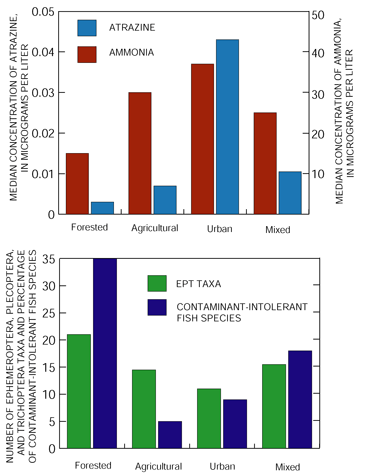 |
| Figure 18. Compared to forested sites, urban and agricultural sites have higher concentrations of atrazine and ammonia as well as lower numbers of fish and invertebrates that are intolerant of contamination. |
Biological communities that inhabit streams in Santee Basin agricultural and urban areas were indicative of degraded water quality compared to those that inhabit streams that drain forested areas. Fish that have a low tolerance for contamination make up a smaller percentage of the fish community at agricultural and urban sites than at forested sites (fig. 18). This can result because fish such as darters and shiners that are sensitive to contaminants do not thrive at degraded sites. Other species such as catfish, redbreast sunfish, and some minnows that are relatively unaffected by contaminants will take the place of the more sensitive fish.
Urban and agricultural streams also had lower numbers of invertebrate species that are intolerant of contaminants than forested and mixed land-use streams. This is evidenced by the lower numbers of Ephemeroptera, Plecoptera, and Trichoptera (EPT) taxa, a group of aquatic insects that are relatively intolerant of contamination, at urban and agricultural sites. The USEPA (Plafkin and others, 1989) uses the presence or absence of EPT taxa as an indicator of aquatic community health.
|
|
|
| Over 85 fish species were identified during ecological sampling in the Santee Basin. |
Water-quality constituents and contaminant-intolerant species are related (fig.18). Median concentrations of ammonia, a nutrient associated with wastewater discharges, and atrazine, an agricultural and turfgrass herbicide, are highest at urban and agricultural sites, corresponding to low numbers of contaminant-intolerant fish and invertebrate species. This suggests that these water-quality constituents have an effect on the aquatic community; however, other factors, primarily those associated with aquatic habitats, can affect aquatic community health in ways that are similar to those that result from changes in water quality. In addition, sample sites were located in several different physiographic provinces, including the Blue Ridge, Piedmont, and Coastal Plain. Differences in species distributions and habitat in these different settings can make comparisons difficult to interpret. Most likely, a combination of water quality and habitat disturbance associated with agricultural and urban land uses results in the observed differences in biological communities.
|
Algal Siltation Index Algal data collected in each of the NAWQA Study Units were combined and compared to show differences in the percentage of species that are able to avoid burial by sediment (Bahls and others, 1992). High percentages of these mobile algae are indicative of siltation of benthic habitats. Two sites in the Santee Basin were in the highest 25-percent category. One of these sites is the Edisto River, a blackwater river that has low light penetration.The high ranking at this site may result from low-light conditions that favor mobile algal species. Other variables that can lower light levels in streams can affect this index, including turbidity and forest canopy closure.
Invertebrate Status Index A multimetric index was developed to compare invertebrate populations nationally. The index is an average of 11 metrics that summarize changes in richness, tolerance, trophic condition, and dominance associated with water-quality degradation. Only one site in the Santee Basin, an urban stream, was placed in the highest 25-percent category. The remaining Santee Basin sites were in the middle category, except for Jacob Fork River and McTier Creek, which were in the lowest category. Both of these sites represent the least degraded water quality in the study area and were located in areas with the least effects of human activity. Nationally, urban and agricultural sites tended to have the most degraded invertebrate communities according to this index.
|
| Table of Contents || Previous Section || Next Section || Glossary U.S. Geological Survey Circular 1206 Suggested citation:
|


